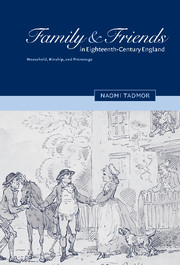Book contents
- Frontmatter
- Contents
- Acknowledgements
- A note on the text
- List of abbreviations
- Introduction
- 1 The concept of the household-family
- 2 The concept of the household-family in novels and conduct treatises
- 3 The concept of the lineage-family
- 4 The language of kinship
- 5 Friends
- 6 Political friends
- 7 Ideas about friendship and the constructions of friendship in literary texts
- Conclusion
- Bibliography
- Index
Introduction
Published online by Cambridge University Press: 30 July 2009
- Frontmatter
- Contents
- Acknowledgements
- A note on the text
- List of abbreviations
- Introduction
- 1 The concept of the household-family
- 2 The concept of the household-family in novels and conduct treatises
- 3 The concept of the lineage-family
- 4 The language of kinship
- 5 Friends
- 6 Political friends
- 7 Ideas about friendship and the constructions of friendship in literary texts
- Conclusion
- Bibliography
- Index
Summary
After decades of academic research on the history of the family in early modern England, scholars and students are both enlightened and perplexed. We now have a very considerable body of knowledge at our command. A field once dominated by ill-informed myths about family life in the past has been enriched with well-researched facts and many well-founded interpretations. Thus, for example, we now possess invaluable data on the demography of the family. We know the mean age at marriage of different populations, the average duration of marriage, rates of remarriage, and the extent of non-marrying populations. We know how many children families in the past were likely to have, how many were born out of wedlock, and how many were likely to die before they reached maturity. Beyond these facts and figures, we know much about conventions of courtship and marriage, as well as the history of marital breakdown. We are aware of different life-cycle stages, from childhood and adolescence to the experience of old age. We know about differences between town and country, rich and poor, east and west, north and south. Indeed, we have many studies that inform us about the experience of particular localities. We also know much about the different experiences of women and men in the past, and about the laws and customs that bred and nurtured these experiences.
This impressive accumulation of facts and interpretations attests to the productivity of historians of the family.
- Type
- Chapter
- Information
- Family and Friends in Eighteenth-Century EnglandHousehold, Kinship and Patronage, pp. 1 - 17Publisher: Cambridge University PressPrint publication year: 2001



